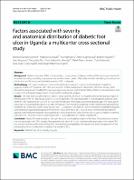| dc.contributor.author | Bienfait Mumbere, Vahwere | |
| dc.contributor.author | Ssebuufu, Robinson | |
| dc.contributor.author | Namatovu, Alice | |
| dc.contributor.author | Kyamanywa, Patrick | |
| dc.contributor.author | Ntulume, Ibrahim | |
| dc.contributor.author | Mugwano, Isaac | |
| dc.contributor.author | Pius, Theophilus | |
| dc.contributor.author | Sikakulya Katembo, Franck | |
| dc.contributor.author | Okedi, Francis Xaviour | |
| dc.contributor.author | Mulumba, Yusuf | |
| dc.contributor.author | Jorge, Soria | |
| dc.contributor.author | Agaba, Gidio | |
| dc.contributor.author | Nasinyama, George William | |
| dc.date.accessioned | 2024-04-26T11:42:37Z | |
| dc.date.available | 2024-04-26T11:42:37Z | |
| dc.date.issued | 2023-03-10 | |
| dc.identifier.issn | 1471-2458 | |
| dc.identifier.uri | https://doi.org/10.1186/s12889-023-15383-7 | |
| dc.identifier.uri | http://hdl.handle.net/20.500.12280/3128 | |
| dc.description.abstract | Diabetic foot ulcer (DFU) is a devastating complication of diabetes mellitus (DM) that is associated with
increased mortality, morbidity, amputation rate and economic burden. This study aimed at identifying the anatomical
distribution and factors associated with severity of DFU in Uganda.
This was a multicenter cross-sectional study conducted in seven selected referral hospitals in
Uganda. A total of 117 patients with DFU were enrolled in this study between November 2021 and January 2022.
Descriptive analysis and modified Poisson regression analysis were performed at 95% confidence interval; factors with
p-value<0.2 at bivariate analysis were considered for multivariate analysis.
The right foot was affected in 47.9% (n=56) of patients, 44.4% (n=52) had the DFU on the plantar region of
the foot and 47.9% (n=56) had an ulcer of >5 cm in diameter. The majority (50.4%, n=59) of patients had one ulcer.
59.8% (n=69) had severe DFU, 61.5% (n=72) were female and 76.9% had uncontrolled blood sugar. The mean age in
years was 57.5 (standard deviation 15.2 years). Primary (p=0.011) and secondary (p<0.001) school educational levels,
moderate (p=0.003) and severe visual loss (p=0.011), 2 ulcers on one foot (p=0.011), and eating vegetables regularly
were protective against developing severe DFU (p=0.03). Severity of DFU was 3.4 and 2.7 times more prevalent in
patients with mild and moderate neuropathies (p<0.01), respectively. Also, severity was 1.5 and 2.5 higher in patients
with DFU of 5–10 cm (p=0.047) and in those with >10 cm diameter (p=0.002), respectively.
Most DFU were located on the right foot and on the plantar region of the foot. The anatomical location
was not associated with DFU severity. Neuropathies and ulcers of >5 cm diameter were associated with severe DFU
but primary and secondary school education level and eating vegetables were protective. Early management of the
precipitating factors is important to reduce the burden of DFU. | en_US |
| dc.language.iso | en | en_US |
| dc.publisher | BMC Springer Nature | en_US |
| dc.relation.ispartofseries | BMC Public Health;23, Article number: 463 (2023) | |
| dc.subject | Diabetic foot ulcer | en_US |
| dc.subject | Severity | en_US |
| dc.subject | Uganda | en_US |
| dc.title | Factors associated with severity and anatomical distribution of diabetic foot ulcer in Uganda: a multicenter cross-sectional study | en_US |
| dc.type | Article | en_US |


